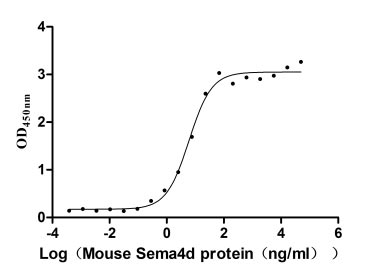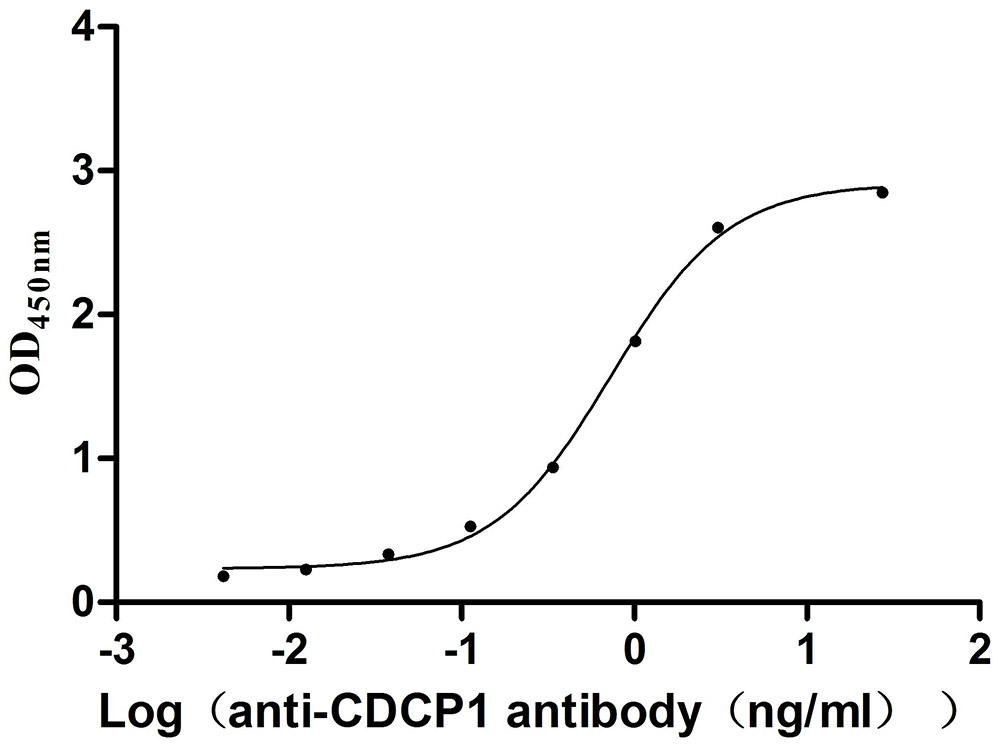Recombinant Mouse F-box/WD repeat-containing protein 7 (Fbxw7)
-
货号:CSB-YP851809MO
-
规格:
-
来源:Yeast
-
其他:
-
货号:CSB-EP851809MO
-
规格:
-
来源:E.coli
-
其他:
-
货号:CSB-EP851809MO-B
-
规格:
-
来源:E.coli
-
共轭:Avi-tag Biotinylated
E. coli biotin ligase (BirA) is highly specific in covalently attaching biotin to the 15 amino acid AviTag peptide. This recombinant protein was biotinylated in vivo by AviTag-BirA technology, which method is BriA catalyzes amide linkage between the biotin and the specific lysine of the AviTag.
-
其他:
-
货号:CSB-BP851809MO
-
规格:
-
来源:Baculovirus
-
其他:
-
货号:CSB-MP851809MO
-
规格:
-
来源:Mammalian cell
-
其他:
产品详情
-
纯度:>85% (SDS-PAGE)
-
基因名:
-
Uniprot No.:
-
别名:Fbxw7; Fbw7; Fbwd6; Fbxw6F-box/WD repeat-containing protein 7; F-box and WD-40 domain-containing protein 7; F-box protein FBW7; F-box protein Fbxw6; F-box-WD40 repeat protein 6; SEL-10
-
种属:Mus musculus (Mouse)
-
蛋白长度:full length protein
-
表达区域:1-629
-
氨基酸序列MRVCVPSSVL VLSCVCWCWG VLLPVPLPNL PFLACLSMST LESVTYLPEK GLYCQRLPSS RTHGGTESLK GKNTENMGFY GTLKMIFYKM KRKLDHGSEV RSFSLGKKPC KVSDYTSTTG LVPCSATPTT FGDLRAANGQ GQQRRRITSV QPPTGLQEWL KMFQSWSGPE KLLALDELID SCEPTQVKHM MQVIEPQFQR DFISLLPKEL ALYVLSFLEP KDLLQAAQTC RYWRILAEDN LLWREKCKEE GIDEPLHIKR RKIIKPGFIH SPWKSAYIRQ HRIDTNWRRG ELKSPKVLKG HDDHVITCLQ FCGNRIVSGS DDNTLKVWSA VTGKCLRTLV GHTGGVWSSQ MRDNIIISGS TDRTLKVWNA ETGECIHTLY GHTSTVRCMH LHEKRVVSGS RDATLRVWDI ETGQCLHVLM GHVAAVRCVQ YDGRRVVSGA YDFMVKVWDP ETETCLHTLQ GHTNRVYSLQ FDGIHVVSGS LDTSIRVWDV ETGNCIHTLT GHQSLTSGME LKDNILVSGN ADSTVKIWDI KTGQCLQTLQ GPSKHQSAVT CLQFNKNFVI TSSDDGTVKL WDLKTGEFIR NLVTLESGGS GGVVWRIRAS NTKLVCAVGS RNGTEETKLL VLDFDVDMK
-
蛋白标签:Tag type will be determined during the manufacturing process.
The tag type will be determined during production process. If you have specified tag type, please tell us and we will develop the specified tag preferentially. -
产品提供形式:Lyophilized powder
Note: We will preferentially ship the format that we have in stock, however, if you have any special requirement for the format, please remark your requirement when placing the order, we will prepare according to your demand. -
复溶:We recommend that this vial be briefly centrifuged prior to opening to bring the contents to the bottom. Please reconstitute protein in deionized sterile water to a concentration of 0.1-1.0 mg/mL.We recommend to add 5-50% of glycerol (final concentration) and aliquot for long-term storage at -20℃/-80℃. Our default final concentration of glycerol is 50%. Customers could use it as reference.
-
储存条件:Store at -20°C/-80°C upon receipt, aliquoting is necessary for mutiple use. Avoid repeated freeze-thaw cycles.
-
保质期:The shelf life is related to many factors, storage state, buffer ingredients, storage temperature and the stability of the protein itself.
Generally, the shelf life of liquid form is 6 months at -20°C/-80°C. The shelf life of lyophilized form is 12 months at -20°C/-80°C. -
货期:Delivery time may differ from different purchasing way or location, please kindly consult your local distributors for specific delivery time.Note: All of our proteins are default shipped with normal blue ice packs, if you request to ship with dry ice, please communicate with us in advance and extra fees will be charged.
-
注意事项:Repeated freezing and thawing is not recommended. Store working aliquots at 4°C for up to one week.
-
Datasheet :Please contact us to get it.
靶点详情
-
功能:Substrate recognition component of a SCF (SKP1-CUL1-F-box protein) E3 ubiquitin-protein ligase complex which mediates the ubiquitination and subsequent proteasomal degradation of target proteins. Recognizes and binds phosphorylated sites/phosphodegrons within target proteins and thereafter bring them to the SCF complex for ubiquitination. Mediates ubiquitination and subsequent degradation of CCNE1 and MYC. Identified substrates include cyclin-E (CCNE1 or CCNE2), DISC1, JUN, MYC, NOTCH1 released notch intracellular domain (NICD), NOTCH2, MCL1 and...显示更多
-
基因功能参考文献:
- Loss of Fbxw7 in the presence of BrafV600E mutation is consequential and sufficient to drive melanoma development. PMID: 28581198
- A novel mouse line carrying a conditional knockin allele of a cancer-specific FBXW7 mutation was established for carcinogenesis study. PMID: 29386660
- results thus suggest that Fbxw7 controls the transcription of MyRF target genes in various tissues through regulation of MyRF protein stability in a manner dependent on MyRF phosphorylation by GSK-3. PMID: 29472293
- FBXW7 is critical for RIG-I stabilization during antiviral responses. PMID: 28287082
- FBXW7 is markedly downregulated in the liver of obese mice. Mechanistically, FBXW7 directly binds to hepatokine fetuin-A to induce its ubiquitination and subsequent proteasomal degradation, comprising an important mechanism maintaining glucose homeostasis. PMID: 29475832
- the regulatory crosstalk between KLF5, miR-29a, and Fbw7/CDC4 cooperatively promotes atherosclerotic development PMID: 29074464
- found that Fbw7 loss caused activation of NF-kappaB signaling. Thus, FBW7 plays a protective role in acute intestinal inflammation by modulating the inflammatory response of NF-kappaB pathway. PMID: 29550488
- EglN2 might act as an FBW7 ubiquitin ligase substrate contributing to the progression of triple negative breast cancer. PMID: 28036276
- These findings highlight the molecular basis of Hajdu-Cheney syndrome (HCS) pathogenesis and provide clinical insights into potential targeted therapeutic strategies for skeletal disorders associated with the aberrant FBW7/NOTCH2 pathway as observed in patients with HCS. PMID: 29149593
- The findings reveal a PLK1-Fbw7-Myc signaling circuit that underlies tumorigenesis and validate PLK1 inhibitors, alone or with Bcl2 antagonists, as potential effective therapeutics for MYC-overexpressing cancers. PMID: 27773673
- Fbxw7 suppresses KrasG12D-induced pancreatic tumorigenesis via a Yap-dependent mechanism. PMID: 27764699
- Myoblast differentiation potential and muscle regeneration can be regulated by Fbxw7beta. PMID: 27594513
- Study identifies a REV-ERBalpha post-translational regulatory circuit in which cyclin-dependent kinase 1 (CDK1) phosphorylation of REV-ERBalpha is recognized by the F-box protein, FBXW7alpha, to direct REV-ERBalpha degradation via the proteasome. Disruption of this CDK1-FBXW7-mediated REV-ERBalpha degradation pathway in mouse liver alters circadian rhythmicity, in particular amplitude, and whole-body lipid/glucose home... PMID: 27238018
- Gene expression profiling reveals transcriptional regulation by Fbxw7/mTOR pathway in radiation-induced mouse thymic lymphomas. PMID: 26575021
- Prion infection induced the expression of FBXW7 in brain. PMID: 25579381
- FBXW7 facilitates nonhomologous end-joining via K63-linked polyubiquitylation of XRCC4 in tumor cells. PMID: 26774286
- data demonstrate that Fbw7alpha negatively regulates osteogenesis by targeting Runx2 for ubiquitin-mediated degradation in a GSK3beta-dependent manner PMID: 26542806
- In mice, an unusually direct antagonism between an E3 ligase and a deubiquitinase, Fbw7 and Usp28, modulate intestinal homeostasis and cancer. PMID: 25716680
- These data show that cell cycle-dependent mechanisms can control ciliary length through a CDK5-FBW7-NDE1 pathway. PMID: 26206584
- Dual regulation of Fbw7 activity by Usp28 is a safeguard mechanism for maintaining physiological levels of proto-oncogenic Fbw7 substrates, which is equivalently disrupted by loss or overexpression of Usp28. PMID: 25437563
- Ubiquitin-dependent degradation of GATA 2 is promoted by Fbw7, is cyclin B-CDK1-mediated Thr176 phosphorylation-dependent, and influences hematopoietic cell differentiation. PMID: 25670854
- Fbw7 is a master regulator of cell fate decisions in the pancreas PMID: 25105579
- FBXW7 modulates cellular stress response and metastatic potential through HSF1 post-translational modification. PMID: 25720964
- these results suggest that FBXW7 antagonizes cancer development in not only a cell-autonomous manner, but also a non-cell-autonomous manner PMID: 25555218
- demonstrate the importance of Fbw7-dependent cyclin E control to the hematopoietic system and highlight chromosome instability as a characteristic feature of dysfunction and malignancy induced by deregulated cyclin E PMID: 24958101
- p50 upregulated c-Myc protein expression mainly through inhibiting its degradation. p50 exhibited this novel property by suppression of FBW7 expression. PMID: 24457827
- Data propose that control of GATA3 levels by Fbw7 contributes to the fine-tuning of T-cell development. PMID: 24820417
- FBXW7 regulates spermatogonial stem cell self-renewal in a negative manner by degradation of MYC PMID: 24879440
- Heterozygous Fbxw7 propellor tip (R482Q) mutations promote intestinal tumors in mice. Heterozygous null Fbxw7 mutations also promote tumours, but the effect is weaker than R482Q. Findings explain the FBXW7 mutation spectrum found in human cancers. PMID: 23676439
- Fbw7 together with GSK3beta negatively regulates G-CSFR expression and its downstream signaling. PMID: 23820376
- the downstream Notch signalling effector HES5 directly represses transcription of the E3 ligase Fbw7beta. PMID: 23776410
- Loss of parkin function through biallelic mutation of PARK2 may lead to death of dopaminergic neurons through unregulated SCF(Fbw7beta)-mediated ubiquitylation-dependent proteolysis of Mcl-1. PMID: 23858059
- inhibition of mTOR signaling pathway suppresses the contribution of Fbxw7 loss toward tumor development. PMID: 23454868
- Fbxw7 controls proliferation and differentiation of keratinocytes, and exerts both inhibitory and stimulatory actions in skin carcinogenesis by counteracting the proliferation-promoting effect of c-Myc and tumor-suppressive effect of Notch. PMID: 22665065
- findings show that Fbxw7 plays a pivotal role in maintenance of quiescence in nondividing leukemia-initiating cells of chronic myeloid leukemia by reducing the level of c-Myc PMID: 23518349
- We demonstrate here the essential function of the Fbw7 E3 ligase for the initiation and the progression of chronic myelogenous leukemia. PMID: 23518350
- a number of miR-25 candidate gene targets PMID: 22912667
- SCF(Fbw7) modulates the NFkB signaling pathway by targeting NFkB2 for ubiquitination and destruction. PMID: 22708077
- Fbxw7 is a potent positive regulator of angiogenesis that limits the activity of Notch in the endothelium of the growing vasculature. PMID: 22848434
- Depletion of Fbxw7 resulted in promotion of induced pluripotent stem cell generation. PMID: 22897623
- Fbxw7 was decreased in NAFLD and negatively correlated with SREBP-1, indicating that the Fbxw7-SREBP-1 axis may play a key pathological role in the development of NAFLD. PMID: 22710480
- identify Fbxw7 as a p53-dependent tumor susceptibility gene. PMID: 22348067
- The F-box protein Fbw7 is required for cerebellar development. PMID: 21827743
- Fbxw7 as a key regulator of the maintenance and differentiation of neural stem cells in the brain. PMID: 21349854
- Loss of Fbxw7 is associated with oxidative stress. PMID: 21205095
- FBXW7 influences murine intestinal homeostasis and cancer, targeting Notch, Jun, and DEK for degradation. PMID: 21282377
- the E3 ubiquitin ligase SCF(FBW7) governs cellular apoptosis by targeting MCL1, a pro-survival BCL2 family member, for ubiquitylation and destruction in a manner that depends on phosphorylation by glycogen synthase kinase 3 PMID: 21368833
- Hepatic ablation of Fbxw7 resulted in hepatomegaly and steatohepatitis, with massive deposition of triglyceride, a phenotype similar to that observed in humans with nonalcoholic steatohepatitis. PMID: 21123947
- C/EBPdelta directly inhibits expression of the tumour suppressor F-box and WD repeat-domain containing 7 gene (FBXW7, FBW7, AGO, Cdc4), encoding an F-box protein that promotes degradation of the mammalian target of rapamycin (mTOR). PMID: 21076392
- miR-223 expression is responsive to acute alterations in cyclin E regulation by the Fbw7 pathway. PMID: 20826802
收起更多
-
亚细胞定位:Nucleus, nucleoplasm. Chromosome.
-
组织特异性:Widely expressed with highest levels in brain, heart and testis.
-
数据库链接:
KEGG: mmu:50754
STRING: 10090.ENSMUSP00000103305
UniGene: Mm.196475




-AC1.jpg)













